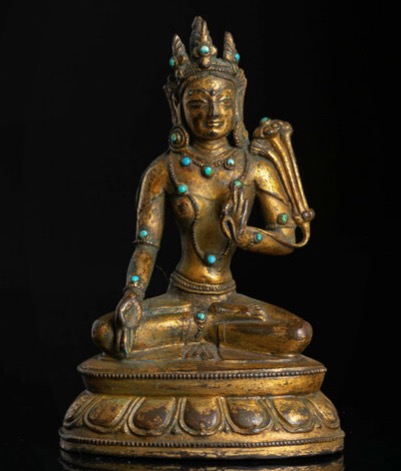15th century, Tibet, ‘standing wrathful deity yab-yum’, gilt copper alloy, 17,3 cm, private collection, Asian Art Auction A207AS lot 107, 28th November 2023, Koller
Unlike Heruka Yakta Ramari, who has red hair and stands on one victim atop a male buffalo, this wrathful male deity with a yaksha appearance has blue hair, topped with a flaming jewel, and stands on two victims atop two buffalos. There is part of a broken implement in his right hand and a skull cup in the other.
His consort holds a skull cup and a flaying knife. They both wear a tiger skin loin cloth, a five-skull crown, bone jewellery and belt; he is adorned with a garland of severed heads and large round earrings, she wears a garland of skulls and floral earrings.
16th century, Tibet, tantric deities in yab-yum, gilt bronze, 11,4 cm, private collection, Asian Art lot 1150, 30th November 2023, Sotheby’s
This one holds a vajra sceptre in his right hand and a skull cup in the other and has the hide of an elephant over his back. His consort has a skull cup in her left hand and possibly a flaying knife in the other, she wears a leopard skin dhoti. They stand on a single victim with a human appearance.
18th-19th century, Tibet, a five-headed deity, silver, 25,5 cm, private collection, Images of Transcendance lot 159, 23rd March 1999, Christie’s Update: this image is labelled ‘Nepal, Shiva and Parvati’ on Lost Arts of Nepal
A semi-wrathful deity with an unusual number of heads, and possibly six arms, in embrace with his consort who may have four heads and the same number of arms. He stands in a dancing pose with one foot on a lotus atop a pedestal with a bull, a lion, and two victims. As in most sculptures of this type, she has a leg around his waist. Among the various attributes with can see a human arm, a bow, flaming jewels, a bell, a trident, on one side, and on the other side a hand making the fear-allaying gesture and another holding a lotus.







































